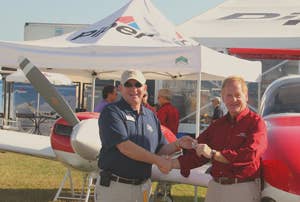
** Simon Caldecott (left) delivers Redbird’s Piper
Seminole to Jerry Gregoire.**
Business at the Redbird Skyport, which opened its doors in San Marcos, Texas, last November, is booming, prompting the company to expand its flight-training program. At the Sun 'n Fun Fly-In and Expo this week, Piper president and CEO Simon Caldecott handed over the keys to a Redbird-branded Piper PA-44 Seminole to Redbird's founder, Jerry Gregoire. The Seminole will be used as part of a new multi-engine curriculum, which will incorporate Redbird's MCX simulator.
Redbird’s general manager of flight operations Roger Sharp said the school has students who are ready to get into the Seminole once it lands in San Marcos.
“Our hope is that one of these days we’ll be able to walk out on the ramp at San Marcos and see Seminoles as far as the eye can see because we’ve been so successful with this program,” said Gregoire.
The Seminole is equipped with Garmin's G500 glass-panel avionics. An in-cockpit video recording system will be installed, which will help Redbird's flight instructors evaluate their students' performance during the flight component of the training.
And Redbird hopes to transform multi-engine training with the new Seminole program. “We’re going to be testing and measuring some things that nobody has ever tried in this aircraft,” said Gregoire. The testing may even include biometrics to evaluate the stress level of the students during different phases of their training, he said.
Redbird is dedicated to reducing the time commitment and cost of flight training. And the dedication to efficiency appears to be working. Even though the school has only been in operation for a few months, it has already graduated more than 20 students. It’s too early for Redbird to provide valuable data as far as the true effectiveness of its flight training programs, but the concept of blending simulator training into the curriculum makes sense. And the Skyport program is constantly evolving based on what appears to be working best.
The simulator setting also functions as a laboratory, in a sense, where different methods of instruction can be easily tested and evaluated. Despite the obvious incorporation of Redbird simulators, the program does not “use the simulator as a substitute for aircraft hours,” said Sharp. “We use the simulator because it’s a more effective platform for building basic skills, and of course it’s more economical for the customer.”

Subscribe to Our Newsletter
Get the latest FLYING stories delivered directly to your inbox






